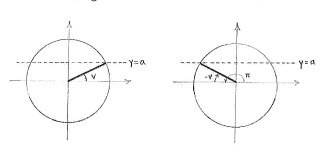Lösung 4.3:3b
Aus Online Mathematik Brückenkurs 1
(Unterschied zwischen Versionen)
K (hat „Solution 4.3:3b“ nach „Lösung 4.3:3b“ verschoben: Robot: moved page) |
|||
| Zeile 1: | Zeile 1: | ||
| - | + | Der Winkel <math>\pi-v</math> bildet denselben Winkel zur negativen ''x''-Achse, wie der Winkel <math>v</math> zur positiven ''x''-Achse bildet. Also ist <math>\pi-v</math> die Spiegelung von <math>v</math> in der''y''-Achse. | |
[[Image:4_3_3_b.gif|center]] | [[Image:4_3_3_b.gif|center]] | ||
| - | + | Bei so einer Spiegelung ändert sich nicht die ''y''-Koordinate, während die ''x''-Koordinate Vorzeichen tauscht. Also ist <math>\sin (\pi-v) = \sin v = a\,</math>. | |
Version vom 11:47, 5. Apr. 2009
Der Winkel \displaystyle \pi-v bildet denselben Winkel zur negativen x-Achse, wie der Winkel \displaystyle v zur positiven x-Achse bildet. Also ist \displaystyle \pi-v die Spiegelung von \displaystyle v in dery-Achse.
Bei so einer Spiegelung ändert sich nicht die y-Koordinate, während die x-Koordinate Vorzeichen tauscht. Also ist \displaystyle \sin (\pi-v) = \sin v = a\,.

